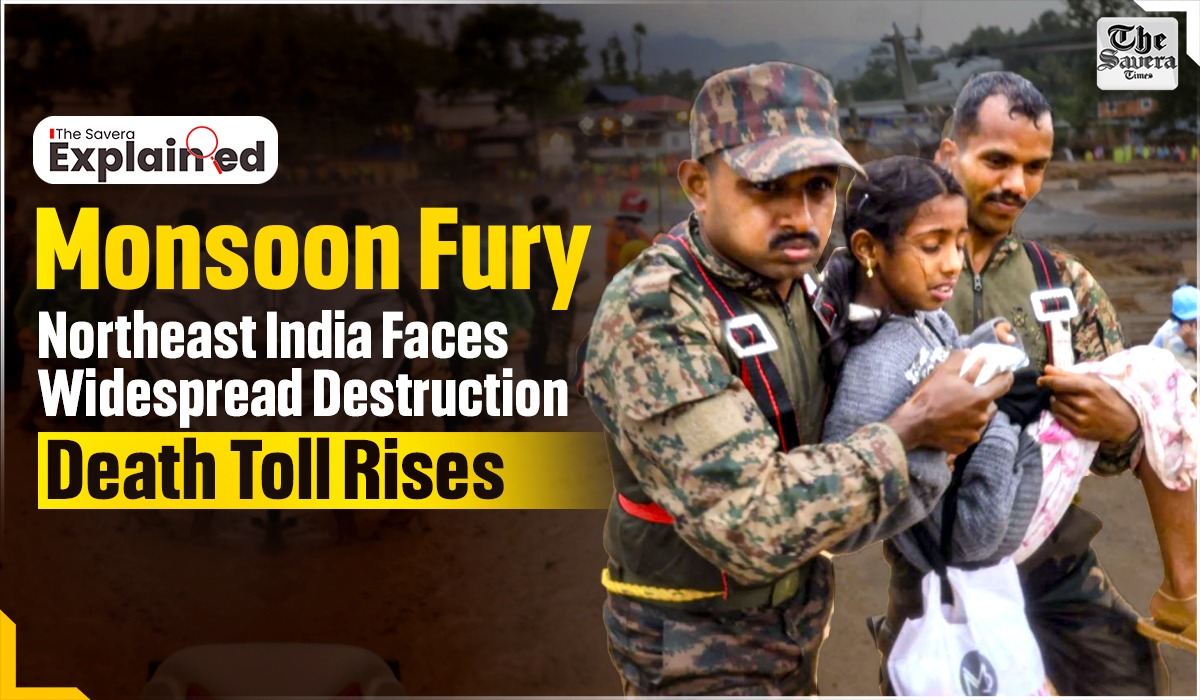
As heavy rainfall lashes the North-eastern parts of India, the region reels under the weight of widespread destruction and human suffering. Torrential downpours have triggered devastating floods and landslides, submerging villages, displacing thousands, and cutting off vital transport and communication links.
The worst hit states involving Mizoram, Assam, Manipur, Tripura, and Arunachal Pradesh, where roads have been washed away, homes flattened and many rendered homeless.
Several people are feared trapped as rescue operations continue amid ongoing rainfall. The India Meteorological Department (IMD) has issued alerts for heavy to very heavy rain in parts of the Northeast, warning of further downpours in the coming day. Sikkim has also been heavily destructed due to landslides triggered by incessant rains.
According to the recent reports, nearly 1500 tourists were stranded in various parts of North Sikkim, the main roads were blocked.
In a tragic accident took place on the Lachen-Lachung highway in the Northern Sikkim, a vehicle carrying 11 people fell over 1,000 feet into the Teesta River. So far, one person has been found dead, two have been rescued and are being treated, while eight people are still missing.
Heavy rainfall and a swollen Teesta River have made rescue operations difficult. The missing include tourists from Odisha, Tripura, and Uttar Pradesh, along with the local driver.
Due to continuous rain and multiple landslides, over 1,400 tourists are stranded in Lachen and Lachung. Authorities have asked them to stay in hotels until roads reopen.
Power and mobile networks have been partially restored, but water supply work is ongoing. No tourist permits are being issued for now. Rescue teams are searching the riverbanks, where they’ve found some ID cards and mobile phones belonging to the missing persons.
Floods across North-eastern parts of India
Eight people have died in Assam due to floods and landslides so far following continuous heavy rainfall that has submerged 17 districts and affected over 78,000 people.
Five of the deaths occurred in Kamrup Metro due to landslides. Three districts are on red alert, and eight others are on orange alert. Rainwater flowing in from Arunachal and Meghalaya worsened the situation.
Massive waterlogging has left parts of Guwahati flooded for the second consecutive day, prompting rescue teams to evacuate stranded residents.
Lakhimpur is the worst-hit district, with over 41,600 people affected. Relief efforts are ongoing, with multiple agencies involved and several relief camps operational.
Mizoram
Heavy rainfall in Mizoram has triggered landslides, killing four people – three of whom were refugees from Myanmar – and injuring one more. The total rain-related death toll in the state now stands at five,
Landslides and rockfalls occurred in multiple locations, damaging 56 homes in 147 incidents across the state. National and intra-state highways have been blocked at 69 points. Sixty-three families have been moved to safer areas. Travellers to southern Mizoram remain stranded in Serchhip as a highway remains blocked by landslides.
Two girls died due to lightning and another person drowned as heavy rain continued in Meghalaya on Saturday. Six deaths have been reported over the past three days. About 1,100 people across 49 villages have been affected by landslides, flash floods, and power disruptions.
Authorities are monitoring the situation, and emergency services are active. Extremely heavy rainfall is forecast in East and South West Khasi Hills in the next 24 hours.
The government is considering calling paramilitary forces to assist in the search for a missing couple from Madhya Pradesh. Rain and poor visibility have delayed the operation since Friday.
Arunachal Pradesh
Chief minister Pema Khandu also expressed grief over nine deaths caused by landslides—seven in East Kameng and two in Ziro valley—and announced ₹4 lakh ex-gratia for each victim’s family.
With more rainfall expected, the CM urged people to remain cautious and avoid unnecessary travel, especially at night. He also warned against going near rivers or streams, as most water bodies in the state are overflowing.
The IMD has forecast heavy rain, thunderstorms, and lightning from June 1 to 5, and continued heavy rainfall on June 5 and 6.
Manipur
Relentless rainfall led to flood-like conditions in parts of Imphal on Saturday, resulting in major waterlogging and disrupting daily life. Streets were submerged in knee-deep water, and traffic was severely affected.
Low-lying areas saw water entering homes and shops, while inadequate drainage systems failed to handle the downpour, forcing locals to take emergency measures to protect their belongings.
These above reports have observed over 30 people have been killed, dozzens feared trapped and thousands more affected as relentless rainfall triggred a series of deadly landslides, flash floods, and widespread devastation across the region.
Rainfall in Northeast India is driven by the Indian Monsoon and unique geography. The southwest monsoon (June–September) brings moist air from the Bay of Bengal, which rises over the eastern Himalayas and hills like Garo, Khasi, and Jaintia, causing heavy orographic rainfall.
The northeast monsoon (October–November) adds moderate showers. Proximity to the Bay of Bengal and the Himalayan barrier intensify precipitation, with areas like Meghalaya receiving 2,000–10,000 mm annually. Pre-monsoon thunderstorms and occasional cyclones also contribute. The region’s tropical climate and dense forests enhance humidity, fostering frequent rain, especially in Assam and Arunachal Pradesh.
